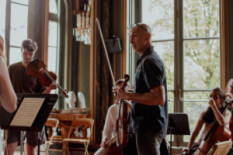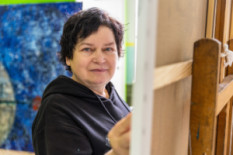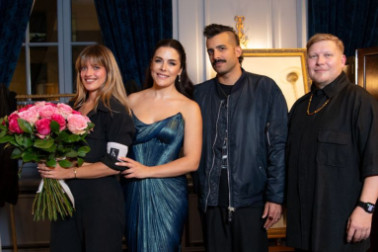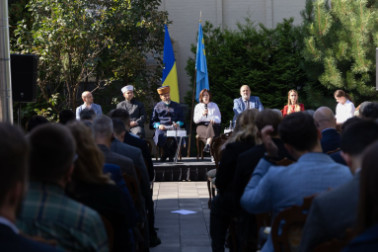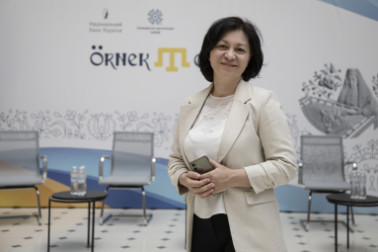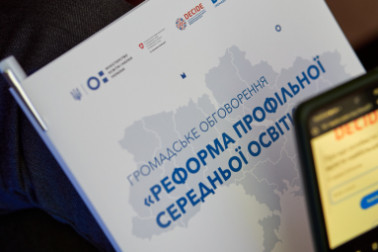Traditions of Embroidery Enthusiasm
Since the late 19th century, the fascination with Ukrainian folk attire, mainly embroidered shirts, has captivated Ukrainians with remarkable regularity, occurring about every 30 years. Initially, figures like Ivan Franko and Lesya Ukrainka introduced embroidered shirts to wardrobes. Later, participants of national liberation struggle in the 1920s-1940s wore them, followed by the artists of the 1960s and, in the early 1990s, activists advocating for Ukraine's independence. The modern wave of embroidered shirt fashion in 2013-2014 was stirred by the Revolution of Dignity and the beginning of the Russian-Ukrainian war in Donbas.
 Poet and writer Ivan Franko wears embroidered shirts with regular attire. Photo - Wikimedia.
Poet and writer Ivan Franko wears embroidered shirts with regular attire. Photo - Wikimedia.
Patriotism and Embroidery Fashion in Ukraine have always walked hand in hand.
However, as mentioned earlier, the Ukrainian embroidered shirt is not unique in the context of folk attire from other nations. Embroidery has adorned clothing in various parts of the world. In Western European countries, specialized books with patterns and techniques for embroidery were published as early as the 15th-16th centuries. Of course, embroidered clothing was not accessible to everyone back then; it was crafted for wealthy citizens and nobility. A widespread European practice, which later reached Ukraine, was embroidering items for sale near monasteries. Renaissance floral motifs and cross-stitch embroidery techniques, now familiar to us, also made their way from Europe to Ukraine.
Embroidery, though ancient, is a dynamic craft that transcends borders. Hence, spotting commonalities between Spanish embroidered designs and, for instance, traditional embroidery patterns from Poltava or Chernihiv is nearly impossible to ignore. Differentiating certain Swiss ("St. Gallen") lace from Ukrainian lace would require experts' discernment.

 Examples of Lagartera folk embroidery from western Spain and a typical pattern from a Poltava embroidered towel.
Examples of Lagartera folk embroidery from western Spain and a typical pattern from a Poltava embroidered towel.
HISTORY
The notion that embroidery as a clothing decoration originated in ancient times is undeniable. However, pinpointing exactly when it occurred remains speculative. Old embroidered clothing and footwear have been discovered during excavations of Scythian burial mounds. It's also known that for centuries, embroidery adorned the attire of Cossack leaders and affluent Ukrainian bourgeoisie. "Discoveries of embroidered garments in Ukrainian territories date far back," says Lyubava Sobutska, head of the folk art department at the Andrey Sheptytsky National Museum in Lviv. "The evolution of this craft likely developed simultaneously in various regions of Europe, including the lands of modern-day Ukraine."

 Photos of Ukrainian women in embroidered shirts, early 20th century, from the British journal The Studio.
Photos of Ukrainian women in embroidered shirts, early 20th century, from the British journal The Studio.
Ukrainians have long adorned various articles of clothing with embroidery. Still, the embroidered shirt we envision today took shape in everyday life relatively recently, around the 19th century.
SYMBOLS AND AMULETS
The art of embroidery has been present since pre-Christian times. It is likely that during that era, numerous images emerged and became established in folk embroidery, symbolizing the forces of nature and cosmogonic concepts of the universe's structure. Signs that attest to our ancestors' pagan beliefs can still be seen in contemporary embroidered items.
Embroidery in clothing served as a talisman. The embroidered pattern was meticulously placed around specific areas – the neckline, chest, and hem. Notably, the solar symbol, the swastika, carried a purely positive meaning from ancient times until the Second World War, symbolizing the sun's movement and associating it with prosperity.

 Details of a recreated ancient embroidered shirt from Rivne region at "Magda Dzvin's Workshop." The black star on the sleeve could have been an embroidered amulet. The shirt is exhibited at the "Living Tradition. My Shirt" exhibition at the National Museum in Lviv in July 2023. Photo — Daria Mazuryk/National Museum in Lviv.
Details of a recreated ancient embroidered shirt from Rivne region at "Magda Dzvin's Workshop." The black star on the sleeve could have been an embroidered amulet. The shirt is exhibited at the "Living Tradition. My Shirt" exhibition at the National Museum in Lviv in July 2023. Photo — Daria Mazuryk/National Museum in Lviv.
"Ornaments on Ukrainian embroidered shirts have constantly evolved over time," says Lyubava Sobutska. "Initially, designs were woven rather than embroidered. The oldest embroidered patterns were geometric motifs. In the 19th century, floral motifs gradually began appearing on shirts. And by the end of the same 19th century, cross-stitch embroidery gradually entered fashion."
The lavish cross-stitched flowers on the sleeves of women's shirts, often seen in old photographs and on the streets of many Ukrainian cities today, are an unmistakable Ukrainian pattern. "This motif was introduced into folk use in the second half of the 19th century for purely commercial reasons," shared Vasil Krychevsky, a Ukrainian artist, architect, and collector known as one of the leading experts in folk ornamentation. "Perfume companies 'Ralle' and 'Brokar and Co' sold soap wrapped in paper with pre-made cross-stitch patterns, copied from Dutch and Flemish magazines. Ukrainian villagers and townsfolk gladly bought this soap because it gave them ready templates for easy embroidery. Cross-stitching allowed for quickly filling large areas of fabric."

 Wrappers for scented soap with ready-made cross-stitch patterns sold in Ukraine in the early 20th century.
Wrappers for scented soap with ready-made cross-stitch patterns sold in Ukraine in the early 20th century.
"Young people wanted to embroider innovations," says Lyubava Sobutska. "They began embroidering floral and intricate patterns, departing from the older designs."
Cross-stitch embroidery patterns quickly spread, people became accustomed to them, and by the early 20th century, the familiar cross-stitch embroidery appeared across most of Ukraine.
RED MEANS LOVE, BLACK MEANS SORROW
Red and black are perhaps the most recognizable and ingrained color combinations in Ukrainian artistic traditions. However, an older color combination was red and blue.
The color palette of embroidered shirts was influenced by the quality of available materials produced domestically. In central Ukraine, threads were made from hemp, while in the northern regions, flax was preferred. Dyed with natural pigments, plant-based threads weren't particularly vibrant; thus, the color palette of old embroidery patterns from these regions was delicate and subtle. Meanwhile, in the Carpathian Mountains, where sheep farming was practiced, fabrics and threads were made from wool. The renowned and beloved Borschiv shirts, with their densely cross-stitched dark sleeves, were once embroidered with black wool threads from sheep. Even without dyeing, their color was rich and intense.
 Embroidered Borschiv shirts. Photo — National Museum of Hutsulshchyna and Pokuttia Folk Art.
Embroidered Borschiv shirts. Photo — National Museum of Hutsulshchyna and Pokuttia Folk Art.
Introducing chemical dyes to local markets in the 19th century fundamentally changed the craft. Embroidery became polychromatic, and plant ornamentation became popular, as the dyes allowed embroiderers to realistically reproduce diverse details on the fabric.
EMBROIDERED SHIRT TREND
There's a common belief that everyone in Ukraine used to wear embroidered shirts (vyshyvankas) all the time, everywhere. Lyubava Sobutska, however, points out that this is a stereotype. "Embroidered shirts were not commonly worn in cities; they were primarily associated with rural attire. In urban areas, embroidered shirts were worn by cultural figures to draw attention and preserve the tradition of folk embroidery. Such attire was collected and often photographed," explains the scholar. "For example, ethnographer Volodymyr Shukhevych and his family appear in numerous photos wearing traditional garments. But did they wear them every day? Probably not."
Collecting embroidered items began among Ukrainians in the late 19th century, coinciding with the establishment of numerous private collections. Amid the tumultuous historical events of the 20th century, many collections were destroyed, lost, or scattered. Fortunately, some parts have made their way to museums and are still preserved.
LIVING TRADITION. MY SHIRT
These days, unique preserved folk costumes and meticulously recreated ancient embroidered shirts can be seen in the Andrey Sheptytsky National Museum exhibition halls in Lviv. The ongoing project is called "Living Tradition: My Shirt."
"No photos or videos can convey the information about embroidered shirts as seeing these, without exaggeration, masterpieces of folk art in person," says Anna Rohatynska, an instructor at the "Magda Dzvin's Workshop" for embroidery. "Authentic Ukrainian embroidered shirts captivate, inspire, and provide an incentive to study and reproduce them."
 A visitor at the "Living Tradition: My Shirt" exhibition admiring the exhibited shirts recreated by the embroiderers of "Magda Dzvin's Workshop."
A visitor at the "Living Tradition: My Shirt" exhibition admiring the exhibited shirts recreated by the embroiderers of "Magda Dzvin's Workshop."
Since 2014, "Magda Dzvin's Workshop" has been conducting comprehensive research on Ukrainian embroidered shirts. This research covers not only embroidery techniques but also authentic shirts' proportions of tailoring, sewing methods, appropriate fabrics, and threads.
Anna Rohatynska notes a robust societal demand for authenticity nowadays, making their workshop's courses highly popular. "People now value not just anything embroidered; it must be authentic. The percentage of those who want to recreate shirts from their region or even their village, where they or their parents originate from, is increasing," Mrs. Rohatynska shares.
 Embroidered shirts created by the embroiderers of "Magda Dzvin's Workshop" at the "Living Tradition: My Shirt" exhibition.
Embroidered shirts created by the embroiderers of "Magda Dzvin's Workshop" at the "Living Tradition: My Shirt" exhibition.
Embroidery, as revealed in the conversation with Anna Rohatynska, is not just about aesthetically decorating everyday life; it's a form of therapy. "People enjoy the process of embroidery," says the master. "The first person who came to our workshop for consultation wrote to us less than a week after a large-scale invasion had occurred. She apologized, thinking it might not be the right time for such inquiries. Still, she said that embroidery was the only thing saving her from depression, bringing her solace. And we provided consultation..."
Over the past decade, the popularity of embroidered shirts in Ukraine has increased due to challenging political events. Many have come to understand the necessity of preserving the culture and traditions of folk art during a war that exhibits all the signs of genocide.
For Ukrainians, the embroidered shirt is not just festive attire. But what is it? Tradition? Fashion? Therapy?... Of course, it's something personal for each individual, yet it's undeniably important and cherished.
